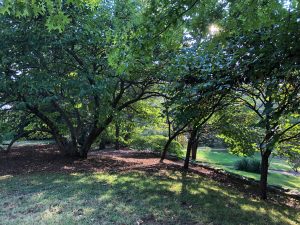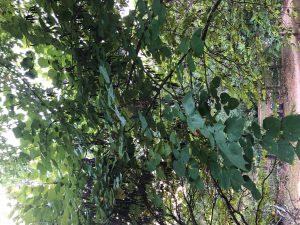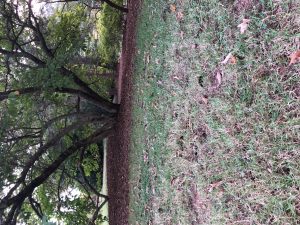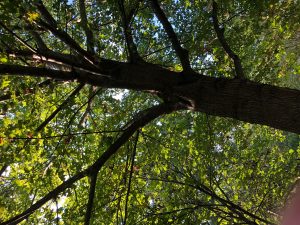
The view, second time around
My sit spot is in the back of the Beale Gardens, right by the meditation chapel (which I have my back to, same as last time). More specifically, if you walked down the steps of the chapel and turned left, I’d be maybe 10 feet away sitting right underneath an oak tree with very dark, very textured bark that is completely covered in grooves. In addition to that, I’m immediately facing another tree that has around 6 large branches that stem from its main trunk, though unfortunately I have to note that I don’t know what kind of tree it is (that isn’t for lack of trying of course, since it’s one of the things I went to check out).

Catalpa tree!
This tree has very light bark compared the others in my immediate area, with a more light grey color than dark brown. It was satisfyingly smooth and not as textured as the others, too, with just a few stray knots here and there. Moving away from the mystery tree, there is also a sort of boundary line made up of dense leaf piles that separates me and the many-branched tree, which I sit around 4 feet away from. Another thing that I wanted to get a closer look of was another, smaller tree that lays right by my oak tree. I identified it as a Catalpa tree by using a tree identification site. Its trunk is slim and dark with chips in it, and its leaves are soft with a slightly darker green on the surface than when you flip it over, same as with the oak tree. The oak tree’s leaves are just a bit of a richer green. Anyhow, there were also these sort of pods that hung from beneath the Catalpa’s canopy that resembles straight brown beans. These were the main objects of interest that I wanted to observe more closely, as they were what my view mainly consisted of and I felt a little bad that I couldn’t identify them previously. These first observations were mainly sight-based.
My nook was rather quiet today, and the only smell I could detect was this sweet damp grass smell coming from around my area. The grass was shining with dew or water when I arrived, it was so pretty! A few other things I observed before walking around, other than the wet grass, were – yes! Mosquitos! I literally came almost an hour earlier than last time, which was as soon as I could manage, and I even changed from my all-black ensemble into a white and lighter colored one! And they still totally swarmed me! I’m bringing a blanket next time and swaddling myself because I seriously cannot afford bug spray. Some of my bites were actually aching a few minutes after. On the brighter side, though, I saw a monarch butterfly! It got super close to me, so I could easily see its bright orange color and patterns.

more leaves on the ground and mystery tree’s unchanged canopy
The large mystery tree that I face, which is one of the three things I’ll be tracking this semester, hasn’t really undergone any noticeable changes since my last blog 2 weeks ago, but the abundance of leaves on the ground definitely did. Last time they were sprinkled sparingly over the ground, but now it’s much more apparent. They’re everywhere, acting as a thing coat, but they are still not as dense as that leafy boundary line I mentioned earlier. Next, I did my best to observe animals other than the mosquitos and butterfly, but I came up unfortunately empty other than the sound of crickets and a few cicadas near the end of my time in the gardens. I thought perhaps the sprinkler system was what made the grass so wet, and maybe that could be a reason as to why the grounds were so empty today, but I’m definitely not counting out the idea that this is part of a natural decline due to seasonal change. We’ll see next week.
One of the adaptations I noticed were how the broadness and large surface area of the leaves on the trees here, as well as their deep green color, would help them better t soak up sunlight in order to survive through the several seasons in temperate deciduous forest biomes. In addition, because of a previous science class, I know that another adaptation is their ability to change color due to the leaves stopping their production of chlorophyll and then dropping to the ground so the tree can conserve water while it’s still cold. The third adaptation, I believe, was the monarch butterfly I saw earlier. I noticed that it was flying south, since I sit facing the west, and I wondered if perhaps that butterfly was starting to migrate already to avoid the cold temperatures late fall will bring.

broad leaves on the oak tree soaking up sunlight
It was so nice actually walking around my sit-spot area and getting a closer look at everything. I’m much more satisfied with my experience since I was able to identify and observe the smaller details in everything. I hope we’ll get the opportunity to do this again soon. Anyhow, that’s all for now, and I’ll see you next time!

I noticed monarch butterflies migrating at my sit spot too, very cool that we can connect this adaptation from class and the hawk lab.
Hopefully a blanket helps with the mosquitos! Sounds like you have a pretty cool spot!
I experienced something very similar with the smell of the grass and the morning dew. I like how you witnessed a butterfly migrating. It sounds so cool!
I’m sorry the mosquitoes are so bad! Is there a lot of stagnant water nearby? Also, I got to see a monarch too! It was super cool :).